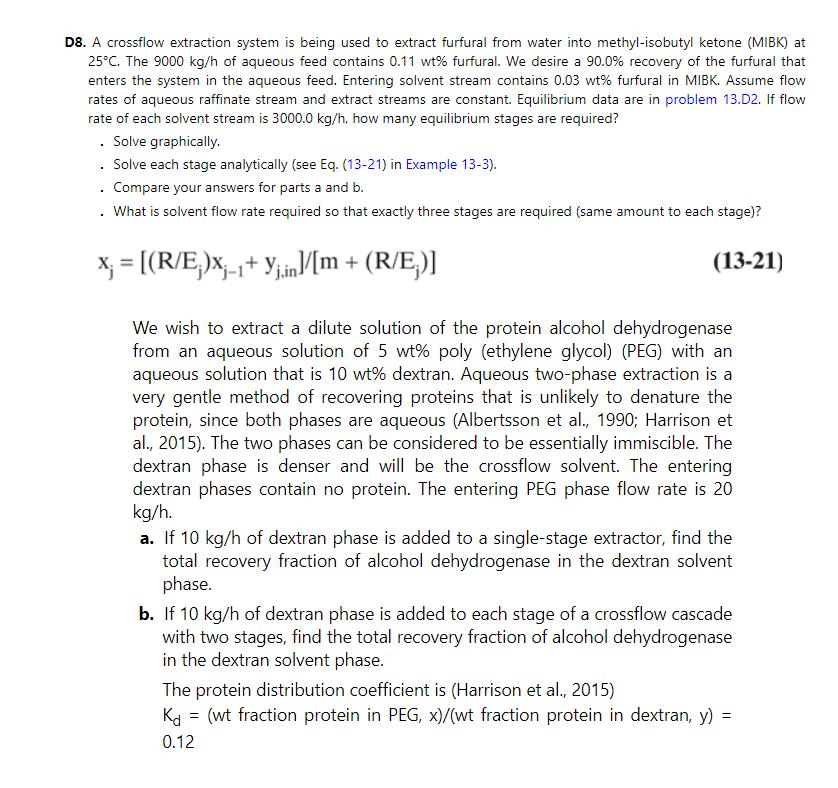Question:
A countercurrent extraction system extracts furfural from water into methyl-isobutyl ketone (MIBK) at \(25^{\circ} \mathrm{C}\). Aqueous feed contains 0.0011 wt. fraction furfural and has a feed rate of \(9000 \mathrm{~kg} / \mathrm{h}\). Recovery of the furfural that enters in the aqueous feed is \(90.0 \%\). Entering solvent stream contains 0.0003 weight fraction furfural and remainder is MIBK. Assume flow rates of raffinate and extract streams are constant. Equilibrium data are \(\mathrm{K}_{\mathrm{d}}=7.1=(\mathrm{wt}\) frac furfural in MIBK \() /(\mathrm{wt}\). frac. furfural in water) (Perry and Green, 1984).
a. How many equilibrium stages are required for a solvent flow rate of \(1500.0 \mathrm{~kg} / \mathrm{h} ?\)
b. Compare the result in part a with solution to problem 13.D8.
c. What is minimum solvent flow rate?
Problem 13.D8

Transcribed Image Text:
D8. A crossflow extraction system is being used to extract furfural from water into methyl-isobutyl ketone (MIBK) at 25C. The 9000 kg/h of aqueous feed contains 0.11 wt% furfural. We desire a 90.0% recovery of the furfural that enters the system in the aqueous feed. Entering solvent stream contains 0.03 wt% furfural in MIBK. Assume flow rates of aqueous raffinate stream and extract streams are constant. Equilibrium data are in problem 13.D2. If flow rate of each solvent stream is 3000.0 kg/h, how many equilibrium stages are required? . Solve graphically. . Solve each stage analytically (see Eq. (13-21) in Example 13-3). . Compare your answers for parts a and b. . What is solvent flow rate required so that exactly three stages are required (same amount to each stage)? x; = [(R/E;)x;-1+ y;.in]/[m + (R/E;)] (13-21) We wish to extract a dilute solution of the protein alcohol dehydrogenase from an aqueous solution of 5 wt% poly (ethylene glycol) (PEG) with an aqueous solution that is 10 wt% dextran. Aqueous two-phase extraction is a very gentle method of recovering proteins that is unlikely to denature the protein, since both phases are aqueous (Albertsson et al., 1990; Harrison et al., 2015). The two phases can be considered to be essentially immiscible. The dextran phase is denser and will be the crossflow solvent. The entering dextran phases contain no protein. The entering PEG phase flow rate is 20 kg/h. a. If 10 kg/h of dextran phase is added to a single-stage extractor, find the total recovery fraction of alcohol dehydrogenase in the dextran solvent phase. b. If 10 kg/h of dextran phase is added to each stage of a crossflow cascade with two stages, find the total recovery fraction of alcohol dehydrogenase in the dextran solvent phase. The protein distribution coefficient is (Harrison et al., 2015) Kd = (wt fraction protein in PEG, x)/(wt fraction protein in dextran, y) = 0.12







